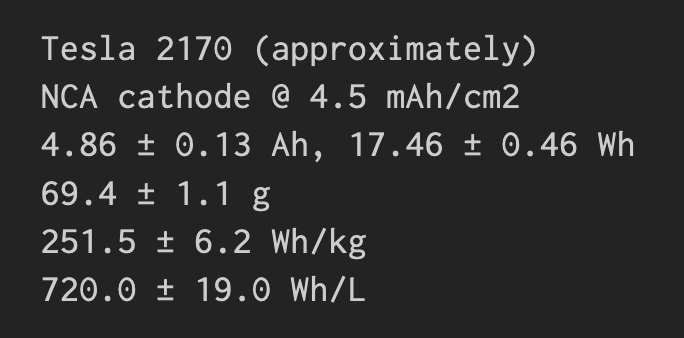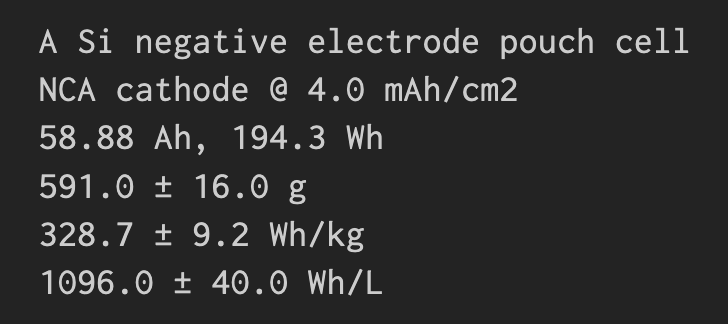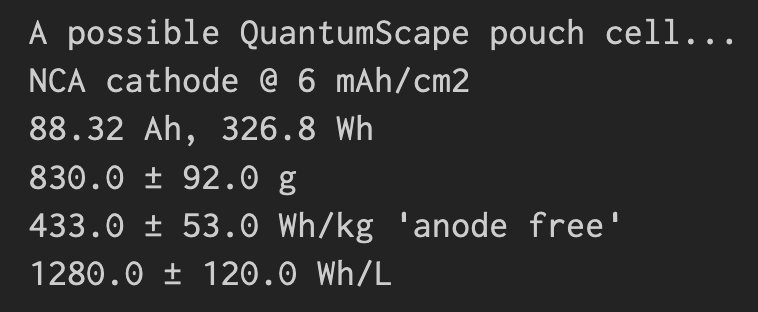Some additional thoughts and numbers on #QuantumScape. Long story short: my estimate is that an "anode-free" solid state cell should fetch ~350 Wh/kg, in the absence of some new miracle positive electrode. Bit lower than 380-480 Wh/kg QS have stated. Thread... 1/
My starting point for my (medium crude) calculations is Tesla - they have probably the most energy-dense +ve on the market now: NCA w/ 90% Ni and a high capacity of ~4.5 mAh/cm2. My cell model gets pretty close to the Model 3 2170 cell numbers, so it& #39;s an ok starting point. 2/
My gut feeling is that QS are going to be using a similar Ni-rich electrode, despite mentions of new conversion cathodes - because I think the latter is one technology leap too many for me to believe without any good evidence to the contrary... 3/
In some of their patents, QS make mention of 4 mAh/cm2 tests of their Li electrodes, so I& #39;m going to assume this is their target and is achievable. I& #39;m also assuming these will be pouch cells. So I& #39;m going to model a pouch cell with NCA, 4 mAh/cm2, and guesstimate dimensions 4/
This is what I got, 23 x 16 cm cell with 20 electrode layers. Bit higher gravimetric and bit lower volumetric compared to cylindrical, sounds ok. Not sure I have a good point of comparison to a real cell but capacity-wise this is around the level of many other EV cells now 5/
For the solid state cell, I have to make some guesses. I& #39;m assuming the electrolyte layer is 15-25 µm (open Q as to whether this is achievable; current batteries have 10-15 µm plastic separators), and that the electrolyte is dense "LLZO" as again patents might suggest. 6/
And here& #39;s my estimate: 355 ± 41 Wh/kg, slightly overlapping with QS& #39;s 380-480 Wh/kg. But >1000 Wh/L volumetric (taking into account volume expansion of the cell after the Li is plated). +31% ± 15% gravimetric and +60 ± 14% compared to the Li-ion version 7/
Out of interest, here& #39;s the same cell but if it would have a pure silicon anode as well, which has been a topic of conversation in the last week - I make it a bit lower gravimetric energy, but around the same volumetric. 8/
A big question is how thin can the solid electrolyte membrane really be made? Shaving 10 µm off to reach the level of today& #39;s polyethylene separators will add 30 Wh/kg on its own by my numbers. Another is volume expansion, this whole cell would expand ~22% during charge 9/
*If* such cells could be realised, then there& #39;s further possible advantages. A solid state cell won& #39;t have the same propensity towards thermal runaway (though I don& #39;t believe in "intrinsically safe") - so cooling requirements in packs etc could be reduced, saving more weight 10/
Of course, plenty of questions still abound. The only publicly available information points to only relatively small, single layer pouch cells so far. Deployment in a production car in 2025 seems far fetched to me, though they do have strong backing. 11/

 Read on Twitter
Read on Twitter






